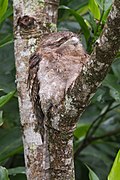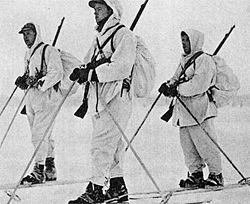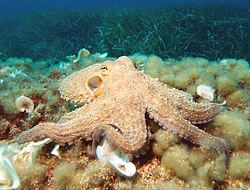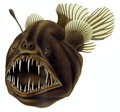List of camouflage methods
Camouflage is the concealment of animals or objects of military interest by any combination of methods that helps them to remain unnoticed. This includes the use of high-contrast disruptive patterns as used on military uniforms, but anything that delays recognition can be used as camouflage. Camouflage involves deception, whether by looking like the background or by resembling something else, which may be plainly visible to observers.[1][2] This article lists methods used by animals and the military to escape notice.
Conventions used
[edit]
Different camouflage methods employed by terrestrial, aerial, and aquatic animals, and in military usage, are compared in the table. Several methods are often combined, so for example the Bushbuck is both countershaded over its whole body, and disruptively coloured with small pale spots. Until the discovery of countershading in the 1890s, protective coloration was considered to be mainly a matter of colour matching,[3] but while this is certainly important, a variety of other methods are used to provide effective camouflage.[1][2]
When an entry is marked Dominant, that method is used widely in that environment, in most cases. For example, countershading is very common among land animals, but not for military camouflage. The dominant camouflage methods on land are countershading and disruptive coloration, supported by less frequent usage of many other methods.[4] The dominant camouflage methods in the open ocean are transparency,[5] reflection, and counterillumination.[6] Transparency and reflectivity are dominant in the top 100 metres (330 ft) of the ocean; counterillumination is dominant from 100 metres (330 ft) down to 1,000 metres (3,300 ft).[6] Most animals of the open sea use one or more of these methods.[6] Military camouflage relies predominantly on disruptive patterns,[7] though methods such as outline disruption are also used, and others have been prototyped.
In 1890 the English zoologist Edward Bagnall Poulton categorised animal colours by their uses,[8] which cover both camouflage and mimicry.[9] Poulton's categories were largely followed by Hugh Cott in 1940.[4] Relevant Poulton categories are listed in the table. Where Poulton's definition covers a method but does not name it explicitly, the category is named in parentheses.
Comparisons
[edit]| Method | Poulton category[4][8] |
Terrestrial, aerial | Aquatic | Military |
|---|---|---|---|---|
| Mimesis: resembling something not of interest to the observer |
Special aggressive resemblance: mimesis by a predator to avoid scaring off prey |
Flower mantis[10]
|
Green frogfish[11]
|
Sunshield[12]
|
| Special protective resemblance: resemblance to a specific object by prey to avoid detection by predators |
Dead leaf butterfly[8]
|
Soft coral spider crab[13]
|
Observation tree, 1916[14] 
| |
| Colour matching: having similar colours to the environment, also known as background matching |
General protective resemblance: resembling the background in a general way |
European tree frog[3]
|
Brown trout[15]
|
Khaki uniforms, 1910[16]
|
| Disruptive coloration: having high contrast coloration that breaks up outlines, so observers fail to recognise the object |
General protective resemblance (a type of) | Papuan frogmouth[17] Dominant |
Commerson's frogfish[18]
|
Disruptive Pattern Material[19] Dominant |
| Disruptive eye mask: a disruptive pattern that covers or runs up to the eyes, concealing them |
Coincident disruptive pattern (a type of) (Cott) | Common frog[20]
|
Jack-knifefish[21]
|
Gun barrel of Sherman Firefly[22] 
|
| Seasonal variation: having coloration that varies with season, usually summer to winter |
Variable general protective resemblance: having coloration that resembles the background in each season, in a general way |
Arctic hare[23]
|
Walleye[24]
|
Snow overalls[25]
|
| Side or Thayer countershading: having graded toning from dark above to light below, so as to cancel out the apparent effect of self-shadowing when viewed from the side |
— | Bushbuck (also has white distractive markings)[26] Dominant |
Blue shark[27]
|
Hugh Cott's guns[28]
|
| Above/below countershading: having different colours or patterns above and below, to camouflage the upperside for observers from above, and the underside for observers from below |
— | Gull (white underside to match sky, improves fishing success)[29]
|
Penguins[30]
|
Supermarine Spitfire[31]
|
| Counterillumination: generating light to raise the brightness of an object to match a brighter background, as of a marine animal's underside against the sea surface |
— | — | Sparkling enope squid[32][33] Dominant (100–1000m) |
Yehudi lights (prototype)[34] 
|
| Transparency: letting so much light through that the object is hard to see in typical lighting conditions |
General protective resemblance (a type of) | Glass frogs[35]
|
Comb jellies[32] Dominant (0–100m) |
1916 trials[36]
|
| Reflection (silvering): reflecting enough light, usually from the sides, to make the object show as a (reflected) patch of the environment |
General protective resemblance (a type of) | — | Pilchard[32] Dominant (0–100m) |
— |
| Self-decoration: covering oneself in materials from the environment |
Adventitious protection: covering oneself in materials that are not part of the body |
Masked hunter bug[37]
|
Decorator crabs[38] |
Ghillie suit[39]
|
| Concealment of shadow: having features such as flanges or a flattened body to reduce or hide the shadow |
— | Flying lizard[40]
|
Tasselled wobbegong[41]
|
Camouflage netting[42]
|
| Irregular outline: having a broken or complex outline (that may help delay recognition by an observer) |
Special protective resemblance (types of) | Comma butterfly[43]
|
Leafy sea dragon[44]
|
Scrim, branches[45]
|
| Distraction: having coloration that distracts an observer's attention away from a feature of the object (such as the head or eye) |
— | Eyespots of peacock butterfly[46] 
|
Foureye butterflyfish[47]
|
False bow wave in ship camouflage[48] 
|
| Distractive markings Small conspicuous marks that distract an observer's attention from recognising the object as a whole[49] |
— | Snowy owl with distractively marked plumage[50]
|
— | Snow camouflage using small distractive marks |
| Active camouflage: changing the coloration rapidly enough to maintain resemblance to the current background while moving |
Variable aggressive resemblance, variable protective resemblance: varying coloration to resemble the background, in predator and prey respectively |
Veiled chameleon[51]
|
Octopuses[52]
|
Adaptiv[53] (see that article for image) |
| Motion camouflage: following a track such that the object remains between a starting point and the target (e.g. prey) at all times, rather than going straight for the target |
— | Hoverfly[54]
|
— | Air-to-air missile[55] Used primarily for efficiency |
| Motion dazzle: rapidly moving a bold pattern of contrasting stripes, confusing an observer's visual processing[56][57] |
— | Zebra[57]
|
— | Proposal only[56] (NB: Marine Dazzle camouflage did not claim this effect) |
| Dazzle camouflage: bold patterns of contrasting stripes, deceiving enemy about ship's heading |
— | — | — | Ship camouflage, mainly WW1[58] Dominant 1917–18 |
| Ultra-blackness: extremely black surface, matching very dark background |
— | Black panther[59] |
Deep-sea fish[60]
|
Night fighters[61] 
|
References
[edit]- ^ a b Cott, 1940. Chapter 1: General Colour Resemblance. pp. 5–19.
- ^ a b Forbes, 2009. p. 51.
- ^ a b Beddard, 1892. p. 83.
- ^ a b c Cott, 1940. Part 1: Concealment. pp. 5–190.
- ^ Johnsen, Sönke (December 2001). "Hidden in Plain Sight: The Ecology and Physiology of Organismal Transparency". Biological Bulletin. 201 (3): 301–318. doi:10.2307/1543609. JSTOR 1543609. PMID 11751243. S2CID 6385064.
- ^ a b c McFall-Ngai, Margaret J (1990). "Crypsis in the Pelagic Environment". American Zoologist. 30 (1): 175–188. doi:10.1093/icb/30.1.175.
- ^ Newark, 2007. p. 154.
- ^ a b c Poulton, 1890. Fold-out after p. 339.
- ^ Forbes, 2009. pp. 51–52.
- ^ Forbes, 2009. p. 134.
- ^ Cott, 1940. pp. 340–342.
- ^ Barkas, 1952. pp. 202–203.
- ^ Cott, 1940. p. 338.
- ^ "Art of the First World War: André Mare and Leon Underwood". The Elm at Vermezeele. Memorial-Caen. 1998. Archived from the original on 29 May 2013. Retrieved 8 February 2013.
- ^ Cott, 1940. p. 28.
- ^ Newark, 2007. pp. 45–46.
- ^ Cott, 1940. p. 148.
- ^ Bester, Cathleen. "Striated Frogfish". Florida Museum of Natural History. Archived from the original on 16 December 2012. Retrieved 12 February 2013.
- ^ Blechman, Hardy; Newman, Alex (2004). DPM: Disruptive Pattern Material. DPM Ltd.
- ^ Cott, 1940. pp. 70–88.
- ^ Barlow, G. W. (1972). "The attitude of fish eye-lines in relation to body shape and to stripes and bars". Copeia. 1972 (1): 4–12. doi:10.2307/1442777. JSTOR 1442777.
- ^ Middle East AFV Technical Letter. The Tank Museum, UK; originally G(Cam) Eighth Army. 26 January 1945.
- ^ Cott, 1940. p. 23.
- ^ Schaefer, Wayne F.; Schmitz, Mark H.; Blazer, Vicki S.; Ehlinger, Timothy J.; Berges, John A. (2014). "Localization and seasonal variation of blue pigment (sandercyanin) in walleye (Sander vitreus)". Canadian Journal of Fisheries and Aquatic Sciences. 72 (2): 281–289. doi:10.1139/cjfas-2014-0139. ISSN 0706-652X.
- ^ "1915 Protective colouring pyrotechnics British Soldier white overalls snow winter clothing uniform camouflage camouflaged". DijitalImaj. Retrieved 22 February 2013. Original publication in "The War Illustrated a Conflict of Nations"
- ^ Ruxton, Graeme D; Speed, Michael P; Kelly, David J (2004). "What, if anything, is the adaptive function of countershading?" (PDF). Animal Behaviour. 68 (3): 445–451. doi:10.1016/j.anbehav.2003.12.009. S2CID 43106264.
- ^ Cott, 1940. pp. 40–41.
- ^ Forbes, 2009. pp. 149–150.
- ^ Rowland, Hannah M. (2009). "Review From Abbott Thayer to the present day: what have we learned about the function of countershading?". Philosophical Transactions of the Royal Society B. 364 (1516): 519–527. doi:10.1098/rstb.2008.0261. PMC 2674085. PMID 19000972.
- ^ Rowland, Hannah M (February 2009). "From Abbott Thayer to the present day: what have we learned about the function of countershading?". Philosophical Transactions of the Royal Society B. 364 (1516): 519–527. doi:10.1098/rstb.2008.0261. PMC 2674085. PMID 19000972.
- ^ Nichols, Steve (2008). Malta Spitfire Aces. Osprey Publishing. p. 16.
- ^ a b c Herring, 2002. pp. 190–195.
- ^ "Midwater Squid, Abralia veranyi". Smithsonian National Museum of Natural History. Retrieved 28 November 2011.
- ^ Bush, Vannevar; Conant, James; Harrison, George; et al. (1946). Camouflage of Sea-Search Aircraft (PDF). Office of Scientific Research and Development, National Defence Research Committee. pp. 225–240. Archived from the original (PDF) on October 23, 2013. Retrieved 12 February 2013.
{{cite book}}:|work=ignored (help) - ^ Naish, D. "Green-boned glass frogs, monkey frogs, toothless toads". Tetrapod zoology. scienceblogs.com. Retrieved 14 February 2013.
- ^ "American Art Native Americans George de Forest Brush Arapahoes". Retrieved 4 September 2015.
In 1916, Brush acquired a small Morane-Borel monoplane (also known as a Morane-Saulnier). He experimented with the possibility of making its wings and fuselage transparent, to reduce its visibility.
See also the Etrich Taube, a 1910 design whose translucency effectively camouflaged it above 1200 feet (400 metres).Naughton, Russell (1 January 2002). "Igo Etrich (1879 - 1967) and his 'Taube'". Monash University. - ^ Wierauch, C (2006). "Anatomy of disguise: camouflaging structures in nymphs of Some Reduviidae (Heteroptera)" (PDF). American Museum Novitates (3542): 1–18. doi:10.1206/0003-0082(2006)3542[1:AODCSI]2.0.CO;2. hdl:2246/5820. S2CID 7894145.
- ^ Hultgren, Kristin; Jay Stachowicz (2011). "Camouflage in decorator crabs: integrating ecological, behavioural and evolutionary approaches" (PDF). In Martin Stevens; Sami Merilaita (eds.). Animal Camouflage. Cambridge University Press. ISBN 978-0-521-19911-7. Archived from the original (PDF) on 2017-08-15. Retrieved 2013-02-12.
- ^ Forbes, 2009. pp. 102–103.
- ^ MacKinnon, Kathy (1992). Nature's Treasurehouse: The Wildlife of Indonesia. Gramedia Pustaka Utama. p. 38.
- ^ Martin, Linda (21 July 2011). "New shark at The Deep heralds summer event". The Deep. Archived from the original on 10 August 2014. Retrieved 18 April 2013.
- ^ Cott, 1940. p. 111.
- ^ Cott, 1940. p. 75.
- ^ Cott, 1940. pp. 341–342.
- ^ Cott, 1940. pp. 359, 362.
- ^ Vallin, A.; Jakobsson, S.; Lind, J.; Wiklund, C. (2005). "Prey survival by predator intimidation: an experimental study of peacock butterfly defence against blue tits". Proceedings of the Royal Society B: Biological Sciences. 272 (1569): 1203–1207. doi:10.1098/rspb.2004.3034. PMC 1564111. PMID 16024383.
- ^ Cott, 1940. p. 373.
- ^ "USS Northampton (CA-26, originally CL-26), 1930–1942". Naval Historical Center. 2002. Archived from the original on 21 July 2012. Retrieved 13 June 2012.
- ^ Dimitrova, M.; Stobbe, N.; Schaefer, H. M.; Merilaita, S. (2009). "Concealed by conspicuousness: distractive prey markings and backgrounds". Proceedings of the Royal Society B: Biological Sciences. 276 (1663): 1905–1910. doi:10.1098/rspb.2009.0052. PMC 2674505. PMID 19324754.
- ^ Thayer, Gerald H.; Thayer, Abbott H. (1909). Concealing Coloration in the Animal Kingdom: An Exposition of the Laws of Disguise Through Color and Pattern; Being a Summary of Abbott H. Thayer's Disclosures. New York: Macmillan. pp. 151–152, 246–247.
- ^ Forbes, 2009. p. 236.
- ^ Forbes, 2009. pp. 236–239.
- ^ "Innovation Adaptiv Car Signature". BAE Systems. 2012. Archived from the original on 18 June 2013. Retrieved 12 February 2013.
- ^ Srinivasan, M. V.; Davey, M. (1995). "Strategies for active camouflage of motion". Proceedings of the Royal Society B. 259 (1354): 19–25. Bibcode:1995RSPSB.259...19S. doi:10.1098/rspb.1995.0004. S2CID 131341953.
- ^ Ghose, K; Horiuchi, TK; Krishnaprasad, PS; Moss, CF (2006). "Echolocating Bats Use a Nearly Time-Optimal Strategy to Intercept Prey". PLOS Biology. 4 (5): e108. doi:10.1371/journal.pbio.0040108. PMC 1436025. PMID 16605303.
- ^ a b Scott-Samuel, NE; Baddeley, R; Palmer, CE; Cuthill, IC (June 2011). Burr, David C (ed.). "Dazzle Camouflage Affects Speed Perception". PLOS ONE. 6 (6): e20233. Bibcode:2011PLoSO...620233S. doi:10.1371/journal.pone.0020233. PMC 3105982. PMID 21673797.
- ^ a b How, Martin J.; Zanker, Johannes M. (2014). "Motion camouflage induced by zebra stripes" (PDF). Zoology. 117 (3): 163–70. doi:10.1016/j.zool.2013.10.004. PMID 24368147.
- ^ Wilkinson, Norman (1969). A Brush with Life. Seeley Service. p. 79.
- ^ Magazine, Smithsonian; Black, Riley. "Why Are Black Leopards So Rare?". Smithsonian Magazine. Retrieved 2023-08-15.
- ^ Davis, Alexander L.; Thomas, Kate N.; Goetz, Freya E.; Robison, Bruce H.; Johnsen, Sönke; Osborn, Karen J. (2020). "Ultra-black Camouflage in Deep-Sea Fishes". Current Biology. 30 (17): 3470–3476.e3. doi:10.1016/j.cub.2020.06.044. ISSN 0960-9822. PMID 32679102.
- ^ Stephenson, Hubert Kirk. (1948) Applied Physics, pp. 200, 258. Science in World War II; Office of Scientific Research and Development. Volume 6 of Science in World War II (Atlantic Monthly Press Book). Editors: Chauncey Guy Suits and George Russell Harrison. Little, Brown.
Bibliography
[edit]- Barkas, Geoffrey; Barkas, Natalie (1952). The Camouflage Story (from Aintree to Alamein). Cassell.
- Beddard, Frank Evers (1892). Animal Coloration: an account of the principal facts and theories relating to the colours and markings of animals. Swan Sonnenschein.
- Cott, Hugh (1940). Adaptive Coloration in Animals. Oxford University Press.
- Forbes, Peter (2009). Dazzled and Deceived: Mimicry and Camouflage. Yale. ISBN 978-0-300-12539-9.
- Herring, Peter (2002). The Biology of the Deep Ocean. Oxford University Press. ISBN 978-0-198-54956-7.
- Newark, Tim (2007). Camouflage. Thames and Hudson. ISBN 978-0-500-51347-7.
- Poulton, Edward Bagnall (1890). The Colours of Animals: their meaning and use especially considered in the case of insects. Kegan Paul, Trench, Trübner.
- Stevens, Martin; Merilaita, Sami (2011). Animal Camouflage. Cambridge University Press. ISBN 978-0-521-19911-7.
- Wickler, Wolfgang (1968). Mimicry in plants and animals. McGraw-Hill. ISBN 978-1-114-82438-6

